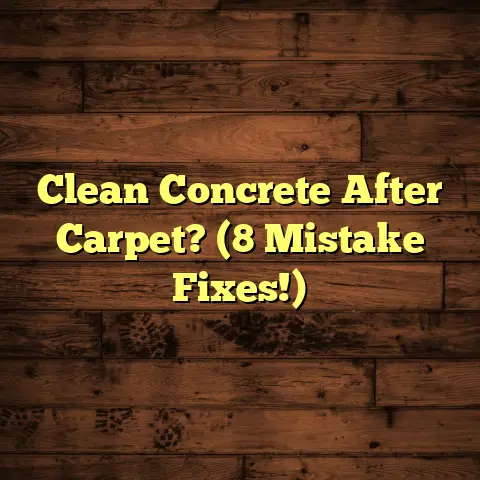Extend The Life Of Laminate Floors In High-traffic Areas? (Explained)
Imagine a bustling train station, where people rush by, carrying their lives in bags and briefcases. Each footfall creates an imprint on the floor, a testament to countless stories unfolding day by day. Just like that station, our homes experience high traffic, especially in areas such as hallways and living rooms. Laminate flooring, while known for its durability and aesthetic appeal, can wear down under such demands. So how do I extend the life of laminate floors in these high-traffic areas? Let me share my journey, filled with successes, challenges, and practical advice.
Understanding the Importance of Care
Every flooring material has its strengths and weaknesses. I’ve installed laminate in various homes, and the key is to treat it right. High-traffic zones are like the busy streets of a city; they need regular maintenance to keep them looking good.
When I first started out, I didn’t realize how much care laminate would need. I remember a project in a residential home where the family had two large dogs. After a few months, those beautiful planks started showing signs of wear. It was a wake-up call for me. I realized that laminate needs attention, especially when it’s subjected to heavy foot traffic.
Regular Cleaning Routines
One of the simplest yet most effective ways to prolong the life of laminate floors is to establish a regular cleaning routine. I usually recommend sweeping or vacuuming at least once a week. Dust and dirt can act like sandpaper, scratching the surface over time.
For deep cleaning, I’ve found that using a damp mop with a gentle cleaner works wonders. Avoiding overly wet mops is crucial because excess water can seep into seams and cause warping. I’ve learned this the hard way during a project where I used too much water. The laminate buckled in areas, leading to costly repairs.
Daily Maintenance Tips
In addition to weekly cleaning, daily maintenance can make a significant difference. Here are some quick tips:
- Wipe up spills immediately: This helps prevent stains and damage.
- Use doormats: Placing doormats at entrances can help trap dirt before it reaches your floors.
- Encourage shoe removal: If clients are open to it, asking guests to remove shoes can drastically reduce wear.
Area Rugs: A Protective Layer
Placing area rugs in high-traffic spots is another strategy I swear by. They act as barriers against dirt and wear. In my experience, choosing rugs with non-slip backing ensures they stay in place.
I’ve had clients who were hesitant about using rugs because they felt they might clash with their decor. However, I encouraged them to think of rugs as part of their interior design rather than just protective layers. For instance, in one home, we added a vibrant runner in the hallway that not only protected the floor but also became a focal point of the decor.
Choosing the Right Rugs
When selecting area rugs, consider the following:
- Material: Look for durable materials like nylon or polypropylene that can withstand foot traffic.
- Color and Pattern: Darker colors or busy patterns can help hide dirt and stains.
- Size: Ensure that rugs are large enough to cover high-traffic areas without being tripping hazards.
Furniture Pads: Small but Mighty
Using furniture pads under heavy pieces can make a significant difference in protecting laminate floors. I always suggest my clients invest in these simple tools. They help prevent scratches when moving furniture around.
I remember working on a project where the homeowners had a large dining table moved frequently for family gatherings. We added felt pads to each leg, and it transformed their experience. They no longer worried about marks on their beautiful laminate.
Types of Furniture Pads
There are various types of furniture pads available:
- Felt Pads: Great for hardwood and laminate floors; easy to apply.
- Rubber Pads: Provide grip and prevent slipping.
- Adhesive Pads: These stick directly to furniture legs for added convenience.
Avoiding Direct Sunlight
Direct sunlight can fade laminate over time, affecting its appearance. I’ve seen this happen in homes with large windows where sunlight streams in all day. Using curtains or blinds can help control light exposure.
In one particular case, I suggested installing UV-blocking window film. The homeowners reported that not only did it protect the floor, but it also kept their home cooler during hot summer months. It’s amazing how sometimes an investment like this pays off in multiple ways.
Window Treatment Options
Consider these options for managing sunlight:
- Blinds: Adjustable and versatile for light control.
- Curtains: Thick curtains can block sunlight effectively.
- Shades: Roller shades or cellular shades provide different levels of opacity.
Managing Moisture and Humidity
Laminate flooring doesn’t fare well in moist conditions. During installations, I always assess the humidity levels of a home. Using dehumidifiers in areas prone to dampness has been a game-changer for many clients.
In a recent project, an elderly couple struggled with humidity in their basement where they had installed laminate. Once we added a dehumidifier, they noticed an immediate improvement in both comfort and floor integrity.
Tips for Moisture Management
Here are some strategies for controlling moisture:
- Regularly check humidity levels: Invest in a hygrometer to monitor indoor humidity.
- Ventilation: Ensure proper ventilation in areas like bathrooms and kitchens.
- Sealant: Consider applying sealant around edges or transitions to prevent moisture ingress.
Cost Estimation with FloorTally
When preparing for laminate installation or maintenance projects, accurate cost estimation is vital. This is where FloorTally comes into play for me. The platform pulls local material and labor rates, allowing me to provide realistic budgets right from the start.
For instance, during one project where I needed to replace damaged planks due to excessive wear, FloorTally helped me calculate costs effectively, factoring in the type of laminate chosen and the labor required for installation. This transparency builds trust with clients and helps avoid surprises down the line.
Features of FloorTally
Some features that make FloorTally invaluable include:
- Local Pricing: Retrieves current market rates for materials and labor.
- Customization Options: Allows me to tailor estimates based on specific project needs.
- Visual Tools: Helps clients visualize costs against different flooring choices.
Choosing Quality Laminate
Selecting high-quality laminate from reputable manufacturers is crucial for longevity. In my experience, more expensive planks often come with better warranties and resistance against wear and tear.
I’ve worked with various brands and have seen firsthand how some hold up better than others in high-traffic areas. For example, brands that offer thicker wear layers tend to perform well under stress.
Factors to Consider When Buying Laminate
When purchasing laminate flooring, keep these factors in mind:
- Thickness: Thicker planks generally offer better durability.
- AC Ratings: Higher AC ratings (like AC4 or AC5) indicate better resistance against wear.
- Warranty: A longer warranty often reflects the manufacturer’s confidence in their product.
DIY vs. Professional Installation
While DIY installation can save money upfront, I’ve seen many homeowners face challenges that lead them to call me for help later on. A common mistake is not properly acclimating the laminate before installation.
In one project, an enthusiastic DIYer didn’t allow the planks to adjust to room temperature. After installation, several planks expanded and buckled within weeks. It’s essential to follow manufacturer guidelines for acclimation to prevent future issues.
Benefits of Professional Installation
Hiring professionals has several advantages:
- Expertise: Professionals know how to handle unique situations and challenges.
- Tools: We have access to specialized tools that ensure precision.
- Warranty Protection: Many manufacturers require professional installation for warranty coverage.
Maintenance Tips for Longevity
- Avoid Harsh Cleaners: Many store-bought floor cleaners contain harsh chemicals that can dull the finish over time.
- Inspect Regularly: Taking time to check your floors for scratches or damage can help catch problems early.
- Rearranging Furniture: Regularly shifting furniture positions can prevent uneven wear patterns.
- Use Dehumidifiers: As mentioned earlier, controlling humidity is vital for laminate longevity.
Additional Maintenance Practices
Beyond these tips, consider incorporating these practices into your routine:
- Annual Deep Clean: Schedule a thorough cleaning at least once a year.
- Professional Maintenance: Hiring professionals for periodic inspections can help identify issues before they escalate.
Handling Repairs
Accidents happen, and knowing how to handle repairs can save you time and money. If you notice scratches or dents, minor repairs can be done with laminate repair kits available at most hardware stores.
In one instance, I had to replace a single plank that was severely damaged due to a pet accident. Knowing how to do this without replacing entire sections saved my client considerable costs.
Common Repair Techniques
Here are some techniques I’ve found helpful over the years:
- Scratch Repair Kits: These usually come with color-matching fillers that blend seamlessly with the floor.
- Replacement Planks: Familiarize yourself with the process of removing damaged planks without affecting surrounding areas.
The Pros and Cons of Different Solutions
After years of working with laminate flooring in high-traffic areas, I’ve gathered insights into various solutions:
- Regular Cleaning: Simple but needs consistency.
- Area Rugs: Effective protection but may require style considerations.
- Furniture Pads: Small investment for significant protection.
- Quality Laminate: Higher upfront cost but pays off over time.
- Professional Installation: May cost more initially but prevents future headaches.
Each approach has its strengths and weaknesses; it’s about finding what works best for you.
Comparative Analysis of Flooring Options
While laminate flooring has its advantages, comparing it with other flooring types can provide additional insights into what might work best for high-traffic areas.
Laminate vs. Vinyl Flooring
Vinyl flooring has become increasingly popular due to its water resistance and variety of designs. Here’s how they stack up:
| Feature | Laminate | Vinyl |
|---|---|---|
| Durability | Good (with AC ratings) | Excellent (water-resistant) |
| Comfort | Moderate (hard surface) | High (soft underfoot) |
| Maintenance | Moderate (regular cleaning) | Easy (spills wipe easily) |
| Cost | Affordable | Varies (can be higher) |
Laminate vs. Hardwood Flooring
Hardwood flooring offers natural beauty but comes at a higher cost and requires more maintenance:
| Feature | Laminate | Hardwood |
|---|---|---|
| Durability | Good | Moderate (depends on type) |
| Aesthetics | Various designs | Timeless beauty |
| Maintenance | Easy | Requires regular upkeep |
| Cost | Generally lower | High |
Embracing New Technologies
The flooring industry continues to evolve with new technologies that enhance durability and ease of maintenance. Innovations like waterproof laminate have emerged as game-changers for high-traffic areas prone to spills or moisture.
I remember installing waterproof laminate for a busy family with young children who often had snacks on the go. This choice not only protected their floors from spills but also provided peace of mind during playtime.
Smart Home Integration
With smart home technology on the rise, integrating flooring systems into your home automation setup can help monitor conditions like humidity and temperature. Smart sensors can alert you if moisture levels rise too high—allowing you to take action before damage occurs.
Unique Personal Stories
Throughout my years as a flooring contractor, I’ve encountered numerous memorable experiences that shaped my understanding of laminate flooring care:
- The Family with Cats: A family I worked with had multiple cats that loved to scratch at everything! We discussed using scratch-resistant laminate paired with area rugs in strategic spots—this not only protected their investment but also gave them peace of mind knowing they could manage potential damage effectively.
- The Busy Office Space: In an office renovation project, we opted for laminate due to budget constraints but knew high foot traffic would be an issue. We recommended thicker planks with AC4 ratings combined with mats at every entry point—this significantly extended the life of their flooring while keeping it looking sharp!
- The Unexpected Flood: One installation turned chaotic when unexpected plumbing issues led to water damage shortly after finishing up! Thankfully we had used waterproof laminate—while some repair work was needed on baseboards and walls—the flooring remained intact!
Actionable Tips Recap
To wrap up all these insights into actionable steps you can take today:
- Establish a regular cleaning routine—sweep weekly and mop monthly.
- Invest in quality area rugs—choose durable materials that complement your decor.
- Use furniture pads—these little gems will save your floors from scratches.
- Monitor humidity levels—consider dehumidifiers if necessary.
- Select high-quality laminate—invest upfront for long-term savings.
- Hire professionals—sometimes it’s worth it to avoid future headaches!
With these strategies in place, you’ll not only preserve your laminate flooring but also create an inviting atmosphere in your home that stands up against everyday life.





